How to choose a digital camera?
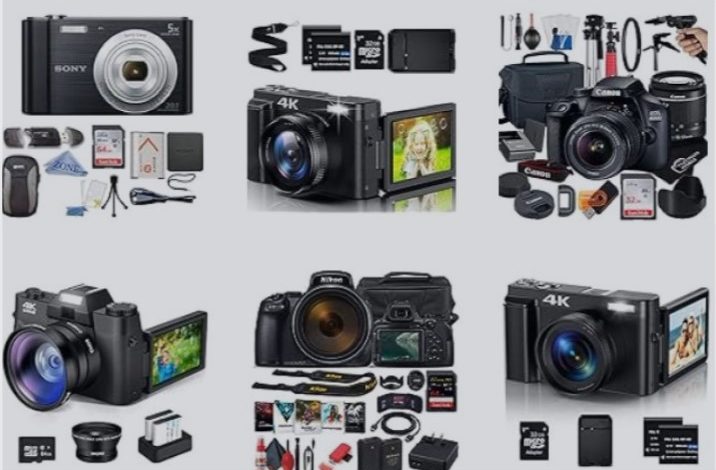
How to choose a digital camera” is a comprehensive step-by-step guide that demystifies the process of selecting the ideal camera for your specific needs. This Ultimate Buying Guide covers essential factors such as sensor size, camera types, and the best camera brands, providing a clear path through the myriad of options available in the market. It recognizes that choosing the right camera can be overwhelming due to the abundance of choices.
Whether you’re an avid traveler looking for a camera to capture stunning landscapes and vibrant street scenes, or a photography enthusiast keen on detailing life’s everyday moments, this guide is tailored to help you. It delves into key considerations such as portability for travel, image quality for high-resolution photographs, and features that cater to various photography styles. By following the outlined steps, you can navigate the decision-making process with ease, ensuring that you choose a digital camera that aligns perfectly with your passion for photography and travel, and enhances your photographic journey.
Table of Contents
Unlock the Power of Electronics
The Perfect Beginner Camera for 2023 – Everything You Need to Know!
1. Determine your needs and budget
When it comes to figuring out how to choose a digital camera, the first critical step is to determine your needs and budget. This initial assessment sets the foundation for a well-informed decision. Start by considering what you primarily intend to use the camera for – is it for casual snapshots, professional photography, vlogging, or something else? Different cameras cater to different needs; for example, a DSLR might be ideal for high-quality images, while a compact camera could be better for everyday convenience.
Next, consider your budget. Digital cameras come in a wide range of prices, from budget-friendly options suitable for beginners to high-end models for professionals. Remember, the cost of a camera often correlates with its features and capabilities, so it’s essential to balance your needs with what you’re willing to spend. By clearly understanding your usage requirements and financial limits, you’ll be better equipped to navigate the vast array of digital cameras on the market. Top 7 Must-Have Portable Chargers for On-the-Go Power!
2. Research different camera types
In your quest on how to choose a digital camera, it’s vital to research the various types of cameras available. Each type offers distinct features and advantages. DSLRs, for instance, are known for their superior image quality and versatility with interchangeable lenses, making them a favorite among professional photographers. Mirrorless cameras, on the other hand, offer similar image quality to DSLRs but in a more compact and lightweight form, ideal for those who value portability without compromising on image quality.
For those seeking simplicity and convenience, point-and-shoot cameras are user-friendly and perfect for casual photography. If adventure is your calling, consider action cameras, which are durable and designed for capturing high-energy activities. Understanding the strengths and limitations of each camera type will help you make a decision that aligns with your photography goals and lifestyle
DSLR (Digital Single-Lens Reflex) Cameras
- DSLRs are versatile and widely used among professional photographers and enthusiasts.
- Advantages:
- Excellent image quality due to larger sensors and interchangeable lenses.
- Extensive manual controls allow for creative flexibility.
- Ideal for capturing fast-moving subjects with continuous autofocus.
- Disadvantages:
- Larger and heavier compared to other camera types, which can be cumbersome for travel.
- Steeper learning curve for beginners.
- Generally more expensive than point-and-shoot cameras.
- Suitability:
- Perfect for those who prioritize image quality, advanced control, and interchangeable lenses.
Mirrorless Cameras
- Mirrorless cameras are becoming increasingly popular due to their compact size and high performance.
- Advantages:
- Lightweight and portable, making them ideal for travel and street photography.
- Excellent image quality with larger sensors and interchangeable lenses.
- Electronic viewfinders provide a real-time preview of the image.
- Disadvantages:
- Battery life is generally shorter compared to DSLRs.
- Less lens options available compared to DSLRs.
- Continuous autofocus may not be as fast for moving subjects.
- Suitability:
- Ideal for photographers seeking a balance between portability, image quality, and manual controls.
Point-and-Shoot Cameras
- Point-and-shoot cameras are compact, affordable, and easy to use.
- Advantages:
- Pocket-sized and lightweight, making them highly portable.
- Simplicity in operation, suitable for beginners and casual photographers.
- Affordable compared to DSLRs and mirrorless cameras.
- Disadvantages:
- Limited manual controls and less room for customization.
- Smaller image sensors may result in slightly lower image quality.
- Restricted options for interchangeable lenses.
- Suitability:
- Perfect for casual photographers who prioritize portability and simplicity in their everyday shooting.
Action Cameras
- Action cameras are designed to capture fast-paced, adventurous moments.
- Advantages:
- Small, rugged, and waterproof, ideal for action-packed activities.
- Wide-angle lens captures a broader field of view.
- Ability to mount the camera on various surfaces.
- Disadvantages:
- Limited manual control options.
- Smaller sensors may result in lower image quality, especially in low-light conditions.
- Non-interchangeable lenses.
- Suitability:
- Great for sports enthusiasts and travelers who want to capture thrilling experiences hands-free.
Remember, understanding the advantages, disadvantages, and suitability of each camera type will be instrumental in making an informed decision that aligns with your photography aspirations. Consider your budget, desired features, and intended usage scenarios to choose the camera that best suits your needs. Happy shooting! Travel in Style with the 6 Best Travel Backpacks of 2024!
3. Consider the megapixel count and sensor size
When delving into how to choose a digital camera, it’s crucial to consider both the megapixel count and the sensor size, as these factors greatly influence the quality of your photographs. The megapixel count is a key determinant of your image’s resolution; higher megapixels mean more detail and clarity in your pictures, especially noticeable when enlarging or cropping them. While it’s tempting to opt for the highest megapixel count, it’s important to align it with your specific needs and the type of photography you’ll be doing.
Equally important is the sensor size. This aspect is critical in determining how well your camera performs under various lighting conditions, particularly in low light. Cameras with larger sensors can capture more light, which translates to higher image quality with less noise in dim settings. Additionally, a larger sensor offers a wider dynamic range, allowing for more nuanced detail in both the brightest and darkest parts of your photos.
To make an informed choice, weigh these specifications against your photography objectives. If you’re planning to shoot in diverse lighting conditions or aspire to have high-resolution images for prints, prioritize these features accordingly. By carefully evaluating both the megapixel count and sensor size of potential cameras, you’ll be better positioned to select a camera that meets your expectations and elevates your photographic experience.
Here’s a column table that outlines the considerations for megapixel count and sensor size in a digital camera:
| Factor | Description | Considerations |
|---|---|---|
| Megapixel Count | Refers to the number of pixels in millions that a camera sensor has. Higher count means higher image resolution. | – Higher megapixels offer better detail and clarity, especially useful for large prints or cropping images. |
| – Assess your need for resolution in your photography (e.g., professional work, enlargements, detailed shots). | ||
| – Remember, more megapixels may increase file size and require more storage space. | ||
| Sensor Size | Refers to the physical size of the camera’s image sensor. Larger sensors generally perform better, especially in low light. | – Larger sensors capture more light, resulting in better image quality in low light. |
| – A larger sensor provides a wider dynamic range, enhancing detail in highlights and shadows. | ||
| – Consider the type of photography you do; larger sensors can be more beneficial for certain styles (e.g., landscape, portrait). |
This table helps in understanding the impact of megapixel count and sensor size on the performance and output of a digital camera.
4. Evaluate lens options
To capture high-quality images, it is crucial to carefully evaluate lens options. Start by understanding the different types of lenses available in the market. Research and compare wide-angle, standard, telephoto, macro, and specialty lenses to determine which suits your photography needs. Consider factors such as the desired level of zoom, aperture range, and image stabilization capabilities.
Next, familiarize yourself with focal lengths and how they affect your photography. Assess whether you require a wide-angle lens for landscapes, a standard lens for everyday shooting, or a telephoto lens for capturing distant subjects. Understand how different focal lengths can create different perspectives and impact the overall composition of your images.
Additionally, ensure compatibility between the lenses and the camera you are considering. Check the lens mount and specifications to confirm that the lenses you desire will fit and function optimally with your camera body.
Finally, consider the availability and affordability of lenses. Investigate the range of lenses available from various manufacturers and their pricing. Keep in mind that lenses can be a long-term investment and that expanding your lens collection in the future can significantly enhance your photography capabilities.
By thoroughly evaluating lens options, understanding focal lengths, assessing compatibility, and considering affordability, you can make an informed decision that will help you create stunning images and further develop your photography skills.
5. Compare features and controls
In your journey on how to choose a digital camera, it’s crucial to compare the features and controls that different models offer. Key features like image stabilization, autofocus systems, ISO range, shooting modes, and connectivity options play a significant role in your photography experience. Image stabilization is vital for reducing blur in handheld shots, especially in low-light conditions. The autofocus system is critical for capturing sharp images of moving subjects, so look for one that’s fast and reliable. The ISO range is another important factor, particularly if you often shoot in varied lighting conditions, as it affects the camera’s light sensitivity and can influence the quality of your photos in dim environments.
Shooting modes, such as portrait, landscape, night, or manual, offer versatility and ease of use in different scenarios. These pre-set modes can be incredibly helpful, especially if you’re still learning the intricacies of photography settings. Connectivity options like Wi-Fi, Bluetooth, or NFC are essential for easily transferring photos to your devices or for remote shooting.
Each photographer has unique needs and preferences, so it’s important to prioritize features that align with your specific photography style and goals. For instance, if you’re into sports photography, a camera with a fast autofocus and high burst rate might be more beneficial than one with extensive connectivity options. Or, if you’re an avid traveler, a lightweight camera with good connectivity for quick sharing could be more appealing. Remember, the best camera for you is the one that not only fits within your budget but also includes the features and controls that will enhance your photographic endeavors.
6. Read reviews and seek recommendations
To make an informed decision, start by reading reviews from reliable sources. Look for feedback and ratings from trusted photography websites or reputable online retailers. These reviews can provide you with valuable insights into the performance, features, and overall quality of the camera you are considering.
Additionally, seek recommendations from photographers or camera enthusiasts who have firsthand experience with the models you are interested in. They can offer valuable guidance based on their personal experiences and help you make a confident choice.
To gather recommendations, join photography forums, Facebook groups, or online communities where photographers share their thoughts, experiences, and opinions about different camera models. Don’t be afraid to ask questions and seek advice from these communities. You’ll likely receive a wealth of knowledge and diverse perspectives that will assist you in making the right decision.
Remember, reading reviews and seeking recommendations are crucial steps to ensure you make an informed choice when purchasing a camera. By listening to the experiences and insights of others, you can gain valuable guidance and confidence in your decision-making process. How to choose a digital camera.
Making the right choice
In conclusion, learning how to choose a digital camera can be a straightforward and enjoyable process. Armed with the insights from these steps, you’re well-equipped to make a choice that’s both informed and satisfying. Start by defining your unique needs and preferences, and then dive into detailed research, comparing features and capabilities. Don’t hesitate to seek advice from photography experts or friends who are seasoned in the art.
The right camera should fit comfortably within your budget while also offering the functionality to capture life’s moments in the way you envision. Remember, selecting the ideal camera is the first step in a journey filled with exploration and creativity. With the perfect camera in hand, you’re ready to unlock a world of photographic possibilities. Here’s to your future filled with stunning captures and memorable experiences. Happy shooting!
Equip Yourself for Success!
- Camera buying guide
- Digital camera brochures
- Camera specifications
- Camera reviews and recommendations
Capture the perfect shot
- Determine your budget: Before diving into options, establish a budget range that you are comfortable with and stick to it
- Define your purpose: Decide what you will primarily use the camera for, whether it’s professional photography, travel, family events, or just capturing everyday moments. This will help narrow down the features you require
- Consider the sensor size: Larger sensors generally produce higher quality images, so if image quality is important to you, opt for a camera with a larger sensor
- Megapixel count isn’t everything: Don’t get overly fixated on the number of megapixels. While it does affect image resolution, other factors like lens quality and sensor size also impact image quality
- Assess the lens options: Research the available lenses for the camera model you’re considering. Having a variety of lenses to choose from will allow you to adapt to different shooting situations and achieve different creative effects
- Look at the camera’s physical attributes: Consider factors like size, weight, and ergonomics. Make sure the camera feels comfortable in your hands and is portable enough for your needs
- Check the user interface: Try to handle the camera and navigate through its menu system. A user-friendly interface will make it easier for you to use and customize the camera settings
- Evaluate the autofocus system: A quick and accurate autofocus system is important, especially for capturing action shots or shooting in low-light conditions. Look for cameras with advanced autofocus features
- Consider connectivity options: If you want to easily share and transfer your photos wirelessly, choose a camera with built-in Wi-Fi or Bluetooth capabilities
- Read reviews and compare models: Take the time to read reviews from reputable sources and compare different camera models. This will give you a better understanding of both the performance and reliability of the camera
Get Empowered: Mastering the Art of Electronics
- Start with the basics: Take the time to understand the basic components and functions of your electronic device. Familiarize yourself with terms like power button, volume control, USB port, and headphone jack
- Read the manual: It may seem obvious, but reading the user manual can provide valuable insights into the features and functionalities of your electronics. Manuals often provide step-by-step instructions, troubleshooting tips, and useful shortcuts
- Experiment and explore: Don’t be afraid to explore different settings and options on your electronic device. Try out different apps, games, or features to get a hands-on experience. This will help you become more comfortable and confident in using electronics
- Seek online resources: With the vast amount of information available online, use tutorials and video guides to deepen your understanding and learn new techniques. Websites, YouTube channels, and forums often provide valuable tips and tricks that can enhance your overall knowledge and usage of electronics
- Practice and patience: Remember, using electronics is a skill that improves with practice. Be patient with yourself and give yourself time to learn and adapt. Embrace the learning process and don’t hesitate to ask for help or seek guidance from others
- Remember, the world of electronics is constantly evolving, so don’t be afraid to keep exploring, learning, and enjoying the wonders of technology!
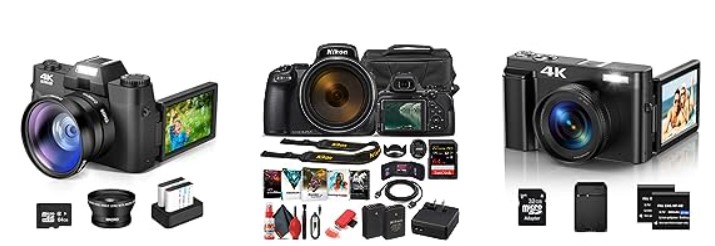
FAQ about How to choose a digital camera
Question 1: What specifications should be considered when buying a digital camera?
Answer 1: When purchasing a digital camera, it’s important to look at a range of specifications to ensure it meets your needs. Here are key aspects to consider: How to choose a digital camera.
Megapixel Count: This determines the resolution of your photos. A higher megapixel count usually means more detail, but also consider how you will use your photos – for large prints or just online sharing?
Sensor Size: Larger sensors typically capture more light and offer better image quality, especially in low-light conditions. Full-frame sensors are top-tier, but APS-C or Micro Four Thirds sensors are also good for most purposes.
Lens Compatibility: If you’re buying a DSLR or mirrorless camera, the range of lenses you can use with it is crucial. Consider the availability and cost of compatible lenses.
ISO Range: This affects the camera’s performance in different lighting conditions. A wider ISO range allows for better low-light photography without excessive noise.
Autofocus System: Look for a system that is fast and accurate, particularly if you plan to shoot fast-moving subjects or action scenes.
Video Capabilities: If you’re interested in video, check for resolution (like 4K or Full HD), frame rates, and other video-specific features such as image stabilization.
Battery Life: Consider how long the camera can operate on a full charge, especially if you plan on using it for extended periods.
Ergonomics and Build: The size, weight, and grip of the camera, as well as the placement of buttons and dials, are important for comfort and ease of use.
Display and Viewfinder: A high-resolution screen or electronic viewfinder can make framing shots and reviewing images much easier.
Connectivity Features: Wi-Fi, Bluetooth, NFC, and GPS are useful for sharing images and remote control functionalities.
Additional Features: Image stabilization, burst shooting speed, weather sealing, and built-in filters can be important depending on your photography style.
Price and Budget: Finally, balance these specifications with your budget. Remember to account for additional expenses like memory cards, cases, and extra lenses.
Carefully considering these specifications will help you find a digital camera that best suits your photography needs and preferences.
Question 2: How do I choose the right camera?
Answer 2: Choosing the right camera involves a blend of assessing your needs, understanding camera features, and considering your budget. Here’s a comprehensive approach to help you make an informed decision: How to choose a digital camera.
Identify Your Photography Needs: Are you a beginner, enthusiast, or professional? Your experience level and what you plan to photograph (landscapes, portraits, sports, etc.) will heavily influence your choice.
Camera Type: Decide between DSLR, mirrorless, point-and-shoot, or action cameras. DSLRs offer great image quality and lens variety; mirrorless cameras provide similar quality with less bulk; point-and-shoots are compact and easy to use; action cameras are best for rugged, on-the-go shooting.
Image Quality and Sensor Size: Higher megapixels don’t always mean better photos. Sensor size plays a more critical role in image quality, especially in low light. Full-frame sensors offer the best performance but are pricier.
Lens Compatibility: If opting for a DSLR or mirrorless, check the variety and availability of lenses. Your choice of lens can be as important as the camera body itself.
Ergonomics and Handling: The camera should feel comfortable in your hands, with controls that are intuitive and easy to access.
Autofocus Performance: A good autofocus system is crucial for sharp images, especially in action or wildlife photography.
Video Features: If you’re interested in video, look for 4K recording, good autofocus during video, and image stabilization.
Battery Life: Consider how long the camera can last on a single charge, particularly if you travel or shoot for extended periods.
Connectivity Options: Wi-Fi, Bluetooth, and NFC are useful for easy photo transfer to your phone or computer.
Budget: Factor in not just the cost of the camera, but also additional expenses like lenses, memory cards, and accessories.
Read Reviews and Test Cameras: Research online reviews and try to test cameras in-store to get a feel for how they operate.
Future-Proofing: Think about how the camera will serve you in the long run. Will it accommodate your growing skills and changing needs?
By carefully considering these factors, you can choose a camera that not only meets your current requirements but also supports your future photography journey.
Question 3: What is considered a good digital camera?
Answer 3: A good digital camera is one that aligns well with your specific photography needs, preferences, and skill level, offering quality, functionality, and features that cater to your style of photography. Here are key aspects to consider: How to choose a digital camera.
Image Quality: High image quality, often determined by sensor size more than megapixels, is a hallmark of a good camera. Larger sensors usually capture more detail and perform better in low-light conditions.
Lens Quality and Compatibility: The camera should either come with a high-quality lens (in the case of fixed-lens cameras) or be compatible with a wide range of quality lenses (for interchangeable lens cameras).
Ergonomics and Design: It should feel comfortable to hold, with controls that are intuitive and easy to navigate. The design should suit your usage, whether it’s compact for travel or robust for professional use.
Autofocus System: A reliable autofocus system that is quick and accurate, especially in different lighting conditions, is essential for capturing sharp images.
Manual Controls and Customization: The ability to manually adjust settings like ISO, aperture, and shutter speed, as well as customizable buttons and dials, are important for more advanced photographers.
Video Capabilities: For those interested in videography, features like 4K video resolution, effective stabilization, and a good autofocus system during video recording are crucial.
Battery Life: Good battery life is essential, especially for travel photography or long shooting sessions.
Connectivity Features: Wi-Fi, Bluetooth, and NFC for easy sharing and transferring of images, as well as USB and HDMI ports, are desirable for convenience.
Durability and Weatherproofing: A robust build quality and weatherproofing are important for shooting in various environments.
Viewfinder and LCD Quality: A clear and bright viewfinder and a high-resolution LCD screen, possibly with touchscreen functionality, enhance the shooting experience.
Additional Features: Image stabilization, burst shooting mode, panorama mode, and in-built filters can add versatility to your photography.
Brand and Support: A reputable brand with good customer support and service options ensures reliability and peace of mind.
Price-to-Performance Ratio: The camera should offer good value for its price, providing the features and quality that justify its cost.
Ultimately, a good digital camera is one that meets your specific requirements, whether you’re a beginner looking for ease of use or a professional demanding high-end features and performance.
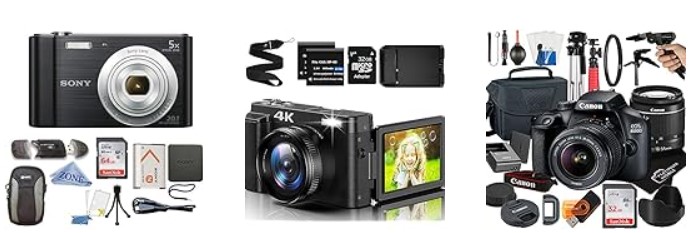
When choosing a digital camera, photography experts often recommend considering the following criteria:
Purpose and Use: Define what you primarily want to use the camera for (e.g., professional photography, casual use, travel, sports, wildlife). Different types of photography may require different camera features. - 100%
Camera Type: Decide between DSLR, mirrorless, point-and-shoot, or action cameras based on your needs. DSLRs offer versatility and high image quality; mirrorless cameras provide similar quality in a smaller package; point-and-shoots are compact and user-friendly; action cameras are best for rugged, outdoor use. - 97%
Image Quality: Consider the megapixel count for resolution, but also look at image processing capabilities and ISO performance for low-light conditions. - 95%
Sensor Size: Larger sensors generally provide better image quality, especially in low light. Full-frame sensors offer the best performance but are more expensive. - 100%
Lens Compatibility and Selection: If you're considering a DSLR or mirrorless camera, check the availability and range of compatible lenses. - 100%
Ergonomics and Size: Think about the camera's size, weight, and how it feels in your hands. This is particularly important if you plan to carry it for long periods. - 99%
Autofocus System: Look for a camera with a fast and accurate autofocus system, especially if you plan to shoot sports, action, or wildlife. - 96%
Video Capabilities: If you're interested in video, check the resolution (4K, HD), frame rates, and whether the camera has features like image stabilization and autofocus during video recording. - 100%
Battery Life: Consider how long the camera can operate on a single charge, especially if you plan to use it for extended periods without access to a charger. - 95%
Connectivity Options: Look for features like Wi-Fi, Bluetooth, NFC, or USB connections for easy transfer of images to other devices. - 99%
Budget and Cost: Determine your budget, keeping in mind that you might need to allocate funds for accessories like lenses, memory cards, and protective gear. - 98%
User Interface and Control Layout: Check if the camera’s interface is user-friendly and if the controls are intuitively laid out for ease of use. - 100%
Extra Features: Consider additional features like image stabilization, weather sealing, touch screen interface, and GPS tagging depending on your specific needs. - 97%
Brand and Support: Research the brand reputation and the customer support offered. Access to service centers and availability of spare parts can be crucial for long-term use. - 99%
Reviews and Recommendations: Read reviews and seek recommendations from other photographers, especially those who have hands-on experience with the models you’re considering. - 100%
98%
Score:
By carefully evaluating these criteria, you can make a more informed decision that aligns with your photography goals and preferences.






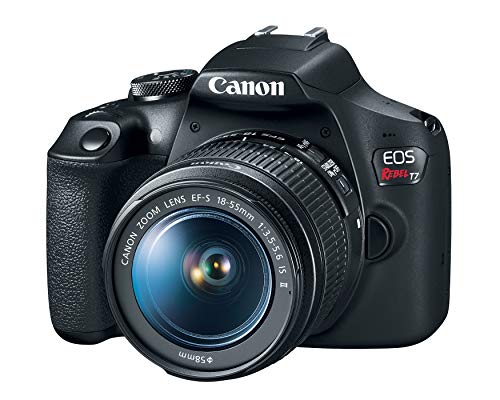













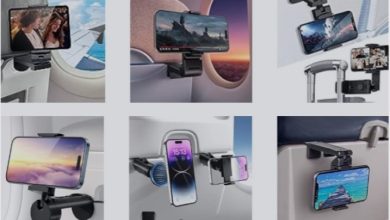
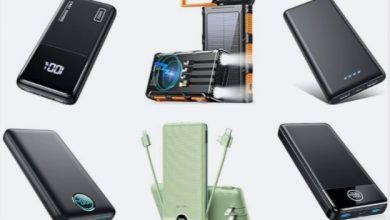
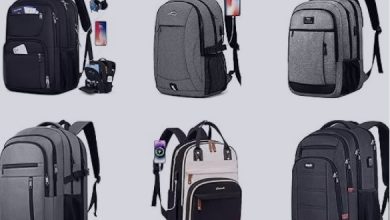
In your recommendation section, you might want to include different budget options for those who are not willing to spend a lot on a camera.
Absolutely, your point about including budget options in the “How to Choose a Digital Camera” article is well-taken. Photography is a passion that should be accessible to everyone, regardless of budget. In the recommendation section, we can certainly include a range of cameras that cater to various financial constraints.
For those who are cautious about investment, there are several budget-friendly cameras that still offer great quality and features. We will look at compact cameras, which are typically more affordable, as well as some entry-level DSLRs and mirrorless cameras that provide excellent value for their price. It’s important to note that a lower price doesn’t always mean lower quality; many budget cameras offer superb image quality and usability, suitable for everyday photography and beginners.
Additionally, we’ll provide tips on what features you can compromise on to fit a smaller budget, and which features are essential, even in a budget camera. For instance, while you might not get 4K video in a lower-priced model, you can still find cameras with excellent image quality and decent low-light performance.
Stay tuned for the updated section with these additions, aimed at making your camera selection process both comprehensive and budget-friendly. Thank you for your valuable feedback!
Overall, this article provided a good starting point for choosing a digital camera. Thanks for sharing!
Thank you for your feedback on the article, “How to Choose a Digital Camera.” We’re delighted to hear that it served as a helpful starting point for you. Our goal is to demystify the process of selecting the right camera by providing clear and concise information, tailored to a variety of needs and preferences.
If you have any more specific questions or need further guidance in your camera selection journey, please feel free to reach out. We’re here to assist whether you’re making your first foray into photography or looking to upgrade your current equipment. Remember, the right camera is not just about the specs; it’s about finding the one that best fits your style and aspirations in photography.
Stay tuned for more updates and articles that delve deeper into the fascinating world of photography. Happy shooting, and may you capture many incredible moments with your chosen camera!
Great article! I found your tips really helpful in narrowing down my choices for a digital camera.
Thank you so much for your kind words about the article, “How to Choose a Digital Camera.” It’s fantastic to hear that you found the tips helpful in narrowing down your choices. Our aim is to make the process of selecting a camera as straightforward and informative as possible, catering to a range of needs and preferences.
If you’ve narrowed down your choices but still have questions or need advice on specific models, don’t hesitate to reach out. We’re here to help you make the final decision that best suits your photography goals and budget.
Also, once you’ve made your choice, we’d love to hear about your experience and how the camera is working out for you. Your feedback could be invaluable to other readers who are on a similar journey.
Remember, the world of photography is an exciting one, and with the right camera in hand, you’re all set to explore and capture its beauty. Happy photographing!
One thing I would have liked to see in this article is a comparison of different camera brands and their strengths.
Thank you for your valuable feedback on the “How to Choose a Digital Camera” article. Your suggestion about including a comparison of different camera brands and highlighting their strengths is indeed a great idea. Understanding the unique qualities and advantages of each brand can significantly aid in making an informed decision that aligns with individual photography needs and preferences.
We will consider updating the article to include a section that delves into the major camera brands, such as Nikon, Canon, Sony, Fujifilm, and others, discussing their specific strong points. For instance, some brands might be renowned for their exceptional low-light performance, while others might stand out due to their advanced autofocus systems or their range of lenses.
Additionally, we could explore the typical user for each brand, be it professionals, enthusiasts, or beginners, to give a clearer picture of which brand might suit which type of photographer.
Your feedback is instrumental in helping us enhance the content and usefulness of our articles. Keep an eye out for future updates, and feel free to reach out with any more suggestions or questions you might have as you continue your journey into the world of digital photography. Thank you once again for your insightful comment!
I think an important consideration when choosing a digital camera is the sensor size. It can greatly impact the image quality.
Thank you for your insightful comment on the “How to Choose a Digital Camera” article. You’re absolutely right about the importance of sensor size. It’s a critical factor that significantly influences the image quality of a camera.
The sensor size determines how much light the camera can capture, which affects the image quality, especially in low light conditions. Larger sensors generally provide better image quality, more detail, and a greater dynamic range. They also contribute to a shallower depth of field, which can be advantageous for artistic effects like bokeh in portraits.
In the article, we might have focused more on other aspects like megapixels, lens types, and features. However, your feedback highlights the need to delve deeper into the topic of sensor sizes. We will look into updating the content to provide more detailed information on how different sensor sizes (such as full-frame, APS-C, Micro Four Thirds) impact the photography experience, as well as which sensor size might be best suited for various photography styles and environments.
Your contribution is greatly valued, as it helps us improve and provide more comprehensive guidance to our readers. If you have any more thoughts or questions about camera features or photography in general, please feel free to share. Your input is always welcome!
I wish you had included more information about mirrorless cameras. It seems like they are becoming increasingly popular.
Thank you for your feedback on the “How to Choose a Digital Camera” article. You bring up a very relevant point about the rising popularity of mirrorless cameras. Indeed, in recent years, mirrorless cameras have become a significant trend in the photography world, known for their compact size, lighter weight, and technological advancements compared to traditional DSLR cameras.
Your suggestion to include more detailed information about mirrorless cameras is well-received. They offer several advantages, such as faster shooting speeds, quieter operation, and often, more advanced video capabilities. Additionally, the electronic viewfinder in mirrorless cameras provides a real-time preview of the final image, which can be a game-changer for many photographers.
In response to your valuable input, we will consider updating the article to cover the features, benefits, and potential drawbacks of mirrorless cameras in more depth. This would include comparisons with DSLRs, recommendations for who might benefit most from a mirrorless camera, and insights into the range of lenses and accessories available for these camera types.
Your feedback is instrumental in helping us improve our content and ensure it remains relevant and informative. If you have any further suggestions or specific questions about mirrorless cameras or other photography equipment, please don’t hesitate to reach out. We appreciate your interest and involvement in making our resources more useful for everyone.
I appreciated that you mentioned the importance of considering the camera’s ergonomics. It’s often overlooked, but it can make a huge difference in the shooting experience.
Thank you for your positive feedback on the “How to Choose a Digital Camera” article. I’m glad to hear that you appreciated the emphasis on the ergonomics of a camera. You’re absolutely right; ergonomics is a crucial aspect that can significantly impact the shooting experience, yet it is often underrated or overlooked.
The comfort of holding a camera, the ease with which you can access the controls, and the overall feel of the camera in your hands can greatly affect not just the enjoyment of your photography sessions but also the quality of the photos you take. A camera that feels right in your hands, with intuitively placed buttons and dials, can make the process of taking pictures more natural and less cumbersome.
In future articles, we aim to explore this topic even more. We could include tips on what to look for in terms of camera size, weight, grip design, button layout, and the viewfinder’s ease of use. We might also discuss how different camera models cater to various hand sizes and shooting styles.
Your appreciation for this detail encourages us to continue providing comprehensive and thoughtful content. If there are any other aspects of camera selection or photography that you find particularly important or would like to learn more about, please feel free to share. Your insights are always welcome, and they help us tailor our content to better serve readers like you.